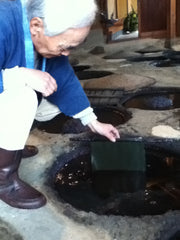Through our Featured Maker Interviews, we learn not just about the people who make our products but the process behind those products. We’ve learned about precious metal clay, stone-cutting tools, and graphic design, and we’d love nothing more than to share everything with you.
But for the sake of readability, we have to cut some material out of our articles; after all, the Featured Maker pieces are about the Featured Makers. But never fear! Our new series, Marvelous Mechanics, shares the unique intricacies behind the making of your favorite products!
We’ll be starting out with our current Featured Maker Nellie Rose Davis and her expertise in an ancient technique of bringing color to cloth through indigo dyeing.

Throughout much of human history, blues, indigos, purples were incredibly difficult colors to come by. A purple stripe on one’s toga denoted status in Roman society, ultramarine paint was the most expensive used by Renaissance artists and would remain so for centuries.
According to Nellie, the ancient Japanese method to procure all-natural indigo dye is to dry, decompose, and ferment the leaves of the indigo plant over the course of several months. This will turn it into the solid dye stuff which can literally last for centuries.

The solid dye stuff must in turn be dissolved in an alkaline solution, which can be extracted from hard wood ash in boiling water. When at the right PH balance, the solution creates the ideal environment for a certain type of bacteria to thrive. Essentially, the indigo is fermenting, and is therefore alive.

Indigo can only enter the fibers in a deoxygenated or reduced environment, which the bacteria provides. Indigo is essentially colorless when in this reduced state, but when it is exposed to oxygen by taking the cloth out of the dye vat, it turns into gorgeous shades of blue.The number of times a fabric is dipped in the dye vat—the different levels of oxidization—determines what shade of indigo the piece becomes. It is possible to achieve an entire rainbow of blues, which shibori resist techniques can be used to achieve.

Nellie confesses to being a little obsessed with indigo and wishes to have her own natural indigo dye studio at some point. She was lucky enough to work with natural indigo with her sensei during her apprenticeship in Japan. She admits that working with natural indigo is like having a child: you can’t leave it alone for too long.
In the last few hundred years, synthetic dyes made with synthetic alkaloids have become more prevalent and have simplified the process and reduced the cost (your blue jeans would be unthinkable without them). But these synthetic alkaloids are incredibly dangerous; Nellie was warned to never attempt working with it without strong gloves. By comparison, natural indigo dye masters will in fact taste their alkaloid solution to test the PH balance (much to Nellie’s initial shock). The simpler and cheaper solution is far more costly in the long run.
Thanks to Nellie Rose Davis for the information in this article! All pictures from the Nellie Rose Textiles Blog!
